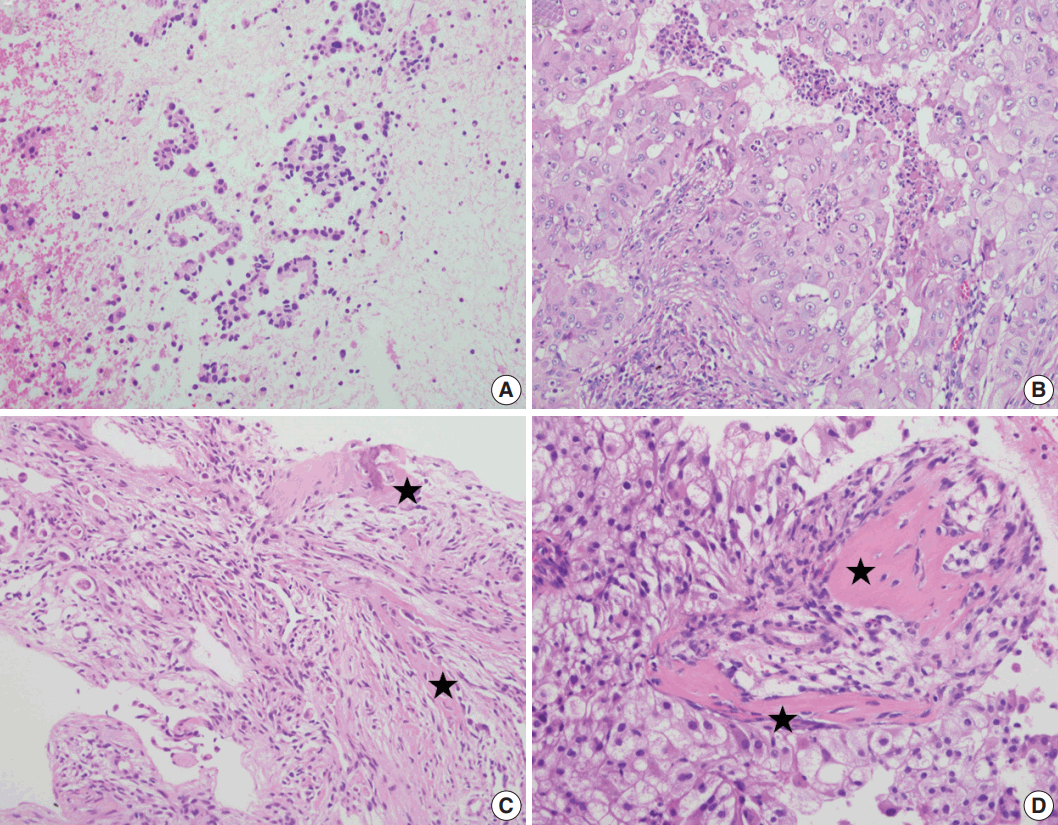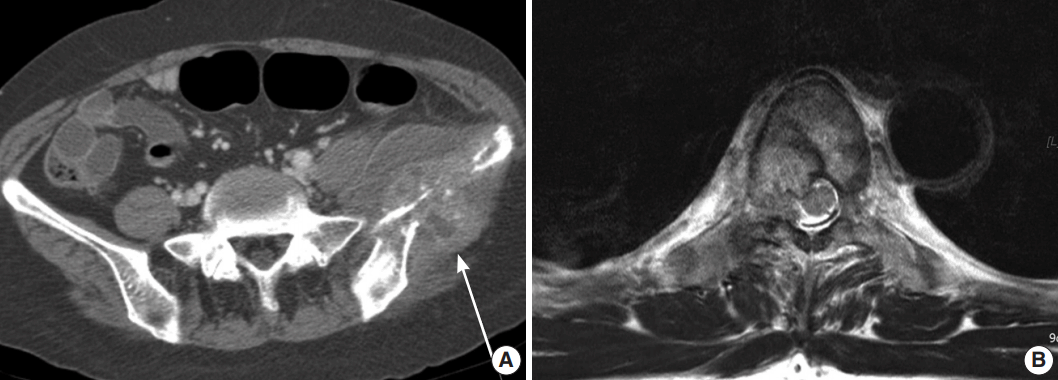Osteosarcomatous Differentiation in Rebiopsy Specimens of Pulmonary Adenocarcinoma with EGFR-TKI Resistance
Article information
Histological transformation of adenocarcinoma such as transformation into small cell carcinoma (SCC) and epithelial to mesenchymal transition (EMT) is one of the discovered mechanisms of the acquired resistance to epidermal growth factor receptor–tyrosine kinase inhibitor (EGFR-TKI). We report two cases of EGFR-TKI resistant pulmonary adenocarcinoma associated with EMT features that showed osteosarcomatous differentiation in rebiopsy specimens.
CASE REPORT
Case 1
A 55-year-old female, non-smoker presenting chronic cough was found to have a mass in the right upper lobe of lung with disseminated intrapulmonary metastasis on computed tomography (CT). CT-guided biopsy of the pulmonary mass revealed a moderately differentiated adenocarcinoma (Fig. 1A) harboring EGFR exon 19 deletion. The initial positron emission tomography–CT and brain magnetic resonance imaging showed metastatic lesions in the left ilium and bilateral cerebral cortex. As first-line therapy, she received one cycle of conventional chemotherapy for 8 days, and then started gefitinib as second-line therapy. After 1 year of continuous gefitinib treatment, radiologic evaluation showed a larger number of metastatic nodules in lung and increased extent of the left iliac metastases with extraosseous ossification (Fig. 2A).

Histologic findings. First biopsy of case 1 (A) and case 2 (B). Microscopic finding of first biopsy reveals adenocarcinoma showing glandular differentiation. Rebiopsy of case 1 (C) and case 2 (D). Microscopic finding shows sarcomatous tumor cells producing osteoid (asterisks).
Case 2
A 58-year-old man who had undergone right upper lobectomy of lung was diagnosed as adenocarcinoma (Fig. 1B) with pT-1N0M0 harboring an EGFR exon 19 deletion mutation. Three years after surgery, metastatic lesions were detected in the right lower lobe and pleura on radiologic findings. He received conventional chemotherapy for 3 months, and then started gefitinib. After 15 months of continuous gefitinib treatment, second biopsy for the pulmonary lesion confirmed T790M mutation, and additional metastatic lesions found in T2 and T5 vertebral bodies (Fig. 2B) were removed by surgical curettage.
Rebiopsy of the metastatic bone lesions of these two patients was performed. Microscopic findings of the tumor showed adenocarcinoma merging with poorly differentiated sarcomatous components. Remarkably, there were spindle shaped sarcomatous tumor cells with eosinophilic cytoplasm producing ill-defined pink acellular lace-like osteoid. These osteoid components were closely associated with the tumor cells and deposited as disorganized features. The sarcomatous neoplastic cells intermingled with osteoid demonstrate unequivocal features of malignancy, which is different from reactive osteoid or callus formation (Fig. 1C, D). EGFR mutation status was same as that of primary lung specimen, and immunohistochemistry showed vimentin expression and decreased E-cadherin.
DISCUSSION
It is known that the resistance to EGFR-TKI is due to various mechanisms. Rebiopsy is usually used to detect the underlying molecular mechanism of resistance; however, meticulous histologic examination is very important to identify the change in cancer phenotype. Histological transformation of adenocarcinoma such as transformation into SCC and EMT is one of the discovered mechanisms in the acquired resistance to EGFR-TKI [1]. EMT is characterized by loss of cell adhesion and acquisition of mesenchymal features, showing morphological change from the epithelial phenotype to the mesenchymal fibroblastoid phenotype. Osteosarcomatous differentiation highly represents EMT features which may contribute to the acquired resistance to EGFR-TKIs. To the best of our knowledge, this is the first report to describe pulmonary adenocarcinoma with osteosarcomatous differentiation in rebiopsy specimens of EGFR-TKI resistant patients.
Here, we describe two cases showing osteosarcomatous differentiation with sarcomatoid features after EGFR-TKI treatment. The malignant osteoid components were distinguished from destroyed and/or regenerating bone elements by their morphology and surrounding poorly differentiated sarcomatous cells in histologic findings. In addition, the ossification of extraosseous sites in radiologic findings is helpful. As the evaluation of metastatic sites for rebiopsy were bone lesions in both patients, the tumor microenvironment may have contributed to the transformation from adenocarcinoma to osteosarcomatous phenotype [2]. A few previous studies suggested that a bone environment is essential for osteosarcoma development from transformed mesenchymal stem cells [3]. Our findings suggest that the differences of the intrinsic nature between epithelial and osteosarcomatous mesenchymal cancers may be the cause of the acquired resistance to EGFR-TKI [4]. In addition, Mink et al. [5] demonstrated that the tumor stroma having cancer-associated fibroblast related to EMT plays an important role in limiting responsiveness to EGFR-TKI.
The phenotypic change in cancer including EMT and histological transformation has been identified as a mechanism of resistance to EGFR-TKI; however, the specific underlying biologic mechanism remains unclear. Further investigations are needed to explain the mechanism of EMT and tumor microenvironment involved in EGFR-TKI resistance.
Notes
Conflicts of Interest
No potential conflict of interest relevant to this article was reported.
